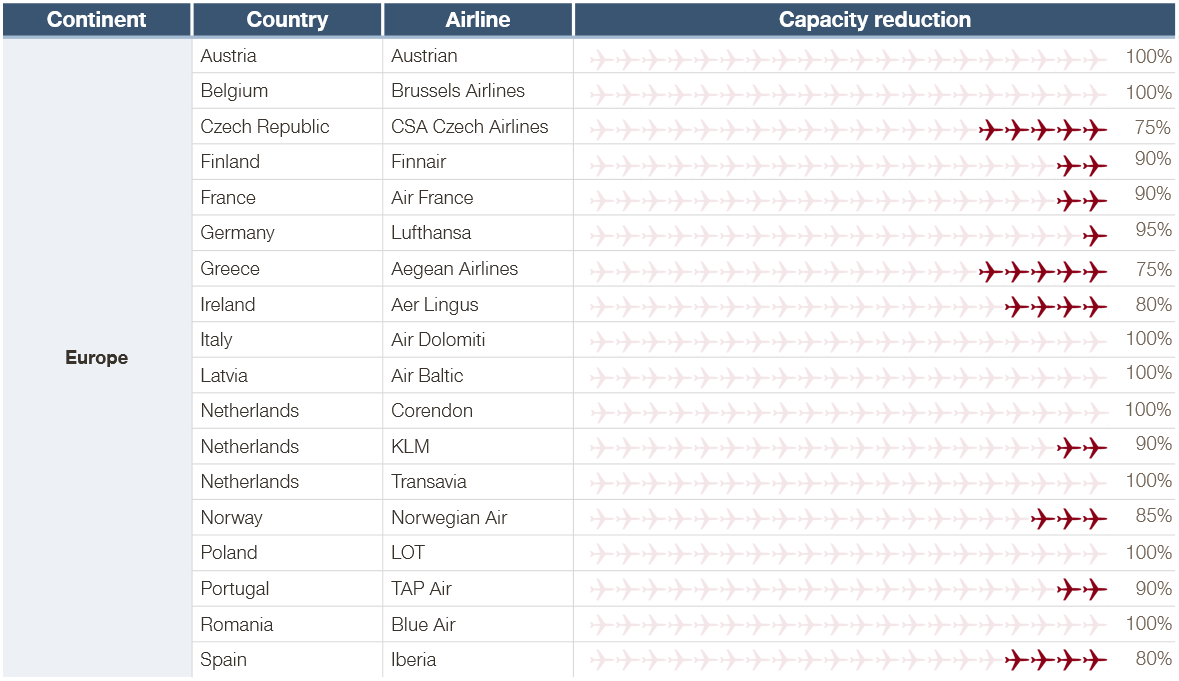Each day brings word of additional cases of COVID-19 (Coronavirus), broader geographic areas significantly affected, more cities and even countries locked down. The airline industry is historically among the most heavily impacted by broad-reaching health events, and this is proving no exception. There was initially hope that the virus could be quickly contained, thereby limiting the impact. Unfortunately, as the confirmed cases of COVID-19 continue to increase and spread globally, it is now a question of how extensively and for how long the crisis will last. As a result, airlines around the world are forced to slash capacity and ground their fleets for a yet unknown period.
Previous pandemics like H1N1 and SARS illustrated that even limited travel advisories could adversely impact travel worldwide. IATA reported1 that within 3 months of the SARS outbreak in APAC, industry-wide demand was down 35%. The current situation is even bleaker with travel bans being introduced more widely and swiftly. IATA’s latest estimates forecast global airline revenue could be reduced up to 252bn USD in 2020 due to COVID-19.
As of 23/03/2020, the average capacity cuts across airlines main hub country
Within this context, how should airline managers steer their business?
Whatever approach you choose, consider the moral and empathetic aspects of any and all commercial initiatives you may activate. Your customers are being bombarded by news of infection hubs – you do not want their smartphone screen to also show a discount from you into that location at the same time.

As of 23/03/2020, On average European airlines are forced to cut capacity by 75 to 100%
Disruptions to travel plans, voluntary and forced, have become common. Fear and uncertainty is impacting booking future travel. Airlines should be – and in larger measure seem to be – much more accommodating and flexible than normal. Waiving change and cancel fees and allowing flexible rebooking will help to improve brand perception, customer reviews, and remove any uncertainty for those who want to book future travel. At the same time, giving back vouchers instead of full refunds for cancelled flights is a clever way to maintain cashflow, while maintaining a customer-centric approach to cancellations.
Consider capping fares as part of your response to the introduction of travel bans to avoid appearing to profiteer from your customers’ need to make last minute flight changes. These are times where it might be best to switch off or constraint your RM systems from going for yield on busy flights and most importantly for heavy discounts in less busy ones. As always, adapting your policies is not enough: you must communicate the efforts being made and their upside to your travelers.
Acknowledge and assuage your customers’ health concerns – tell them what you are doing to make their journey as safe as possible. Best practice companies describe the precautions they are taking to ensure the health and safety of travelers and employees, whether it is pre-boarding screening or onboard precautions for cleaning and sanitizing. Expect cleanliness to be a concern, so make hand sanitizers and disinfectant wipes readily available for all. Take extra steps to disinfect the aircraft, lounge, and gate areas, and communicate this to your customers.
Cement relationship with your most loyal customers. Make special, personalized offers available to your loyalty members. Also, at times of low utilization, offer them free upgrades to business & first class. Maintain the relevance of your loyalty scheme by increasing opportunities for earning and burning points with 3rd party partners. Rather than deeply discounted fares, provide specials on points for flights to help boost demand to help maintain pricing integrity in the market. Recognize the unprecedented nature of this travel disruption and consider extending the validity of member points as well as the criteria and time period for maintaining and earning status.

The airline industry is now in an unprecedented downturn as demand has evaporated almost overnight. Disruption amid the coronavirus pandemic is of an unknowable duration, however, the impact of how you treat your customers can have a long lasting impact and can help to burnish your brand and cement loyalty. Fear can be a larger motivator than price, so look beyond discounting to stimulate demand.
How you treat your most loyal customers now can pay dividends later. Lastly, best practice companies will use this down period to begin planning their recovery strategy so they won’t be caught flat footed when the all-clear is given and demand takes off.

